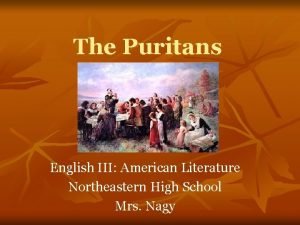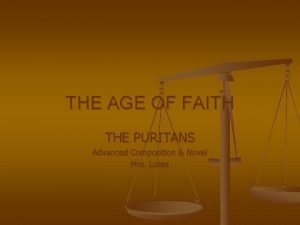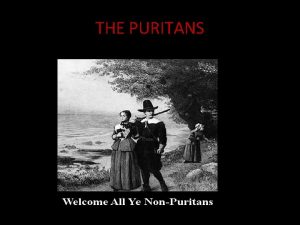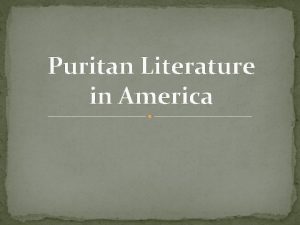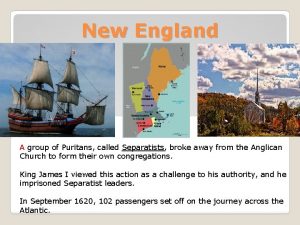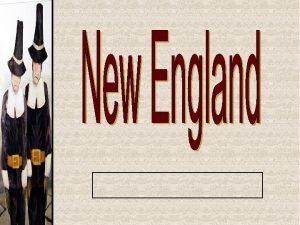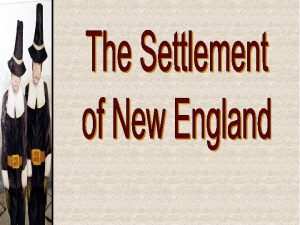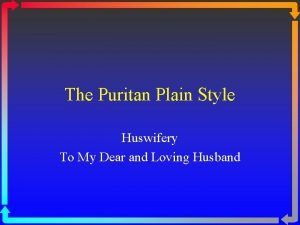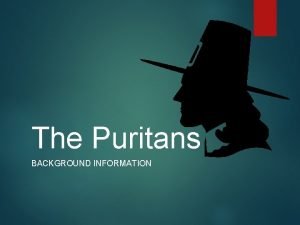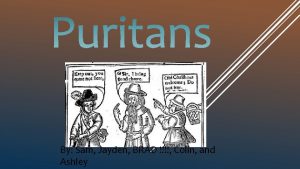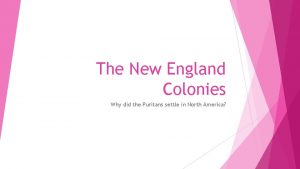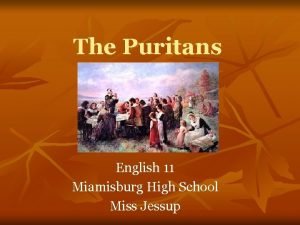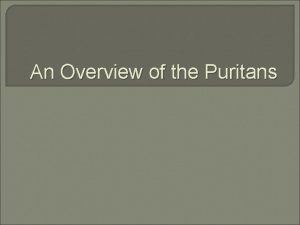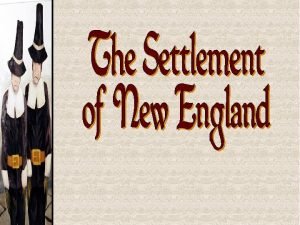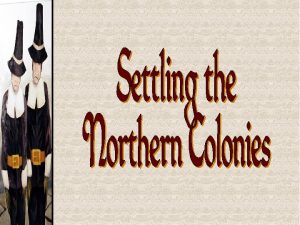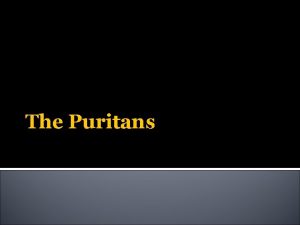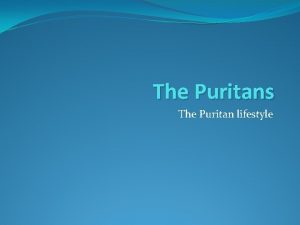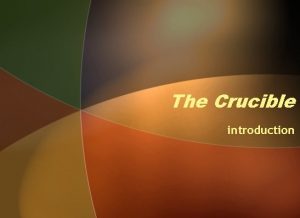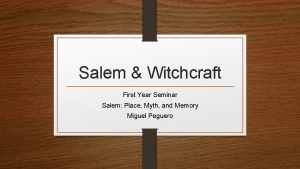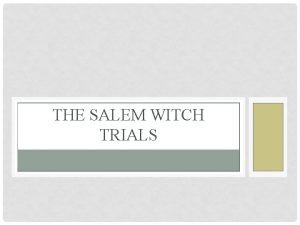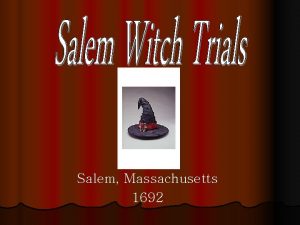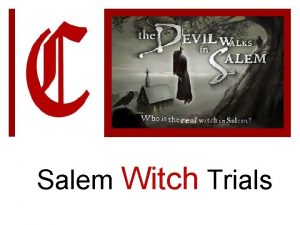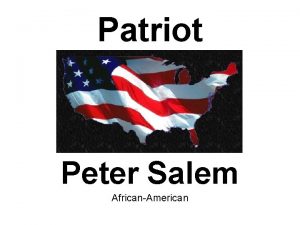The Puritans The Puritans Lifestyle Literature Religion Salem


















- Slides: 18

The Puritans • • • The Puritans Lifestyle Literature Religion Salem and the history of witchcraft • Arthur Miller’s The Crucible • Events and Technology Page 1 Timeline

The Puritans • The Puritans were an English religious group who came to the United States to practice their religion without interference from the Church of England. The Puritans were pilgrims, but not all pilgrims were Puritans. Most Puritans settled in towns in coastal Massachusetts just slightly north of Boston. • The Puritans had their own unique community and cultural practices, most of them based on their religious beliefs. It is important for us to understand the Puritan customs and culture before we can begin reading The Crucible, which takes place in one of these Puritan communities: Salem, Massachusetts Page 2

The Puritans • Puritans, sometimes called Separatists, are those who reject the organized denominations' claims of authority. Church of England Separatists made up one small group, which began breaking away as early as the 16 th Century. By far the largest group of Puritans came out of the Presbyterian Church, while the second largest group came from the Baptists. • In a time when hatred and persecution existed between many denominations, every denomination in Europe hated and persecuted the Puritans. One small group after another boarded ships and came to America. Page 3

The Puritans The "Witch House" dates back to the first Puritan settlers (1642). It was the home of a witch trial judge, Jonathan Corwin (who is not in The Crucible). Page 4

The Puritans-Summary • Theocracy: A government run by God, or in the absence of God, his church. It is a union of the church and state. • They wanted to reform their national church by eliminating every shred of Catholic influence • Their attempt to “purify” the Church of England their own lives was based on the teachings of John Calvin • Left for the new world in 1620 to escape religious persecution and established the Massachusetts Bay Colony. Page 5

The Puritans --Lifestyle • Religion played an important role in Puritan life. The Puritans felt that they were chosen by God for a special purpose and that they must live every moment in a God-fearing manner. Every man, woman, and child was expected to attend the meeting on the Sabbath without question. Puritans were required to read the Bible which showed their religious discipline. If they did not read the Bible, it was thought that they were worshiping the devil. • Preparations for the Sabbath began the day before. All of the food had to be cooked and clothes ready. No labor, not even sewing, could be done on the Sabbath. Page 6

The Puritans-Lifestyle • In church, the minister would deliver an emotional sermon that could last for two, three, even four hours at a time without restroom breaks or intermissions. The Puritans listened intently to the terrible warnings of sin and punishment. • Church Deacons kept strict order in the church. Using a "staff, " deacons would poke anyone misbehaving in church. • Churches were unheated and for many months of the year and in the winter were unbearably cold. Women carried small foot-stoves from home full of hot coals which were used to warm their feet during the church service. Page 7

The Puritans-Literature • There was no reading for pleasure • Writers opposed ornate style—used only plain style. Reason, logic, order and clarity were more prized in literature than beauty or adornment. • Writing should be useful—a tool to help readers understand the Bible and guide them in their daily lives. • Types of literature: sermons, utilitarian, medical, religious, poetry (secretive) and personal narratives. Page 8

The Puritans-Religion • Total depravity: “In Adam’s fall we sinned all” Humankind is totally sinful through the fall of Adam and Eve and damned for eternity. • Predestination: You are “elect” (saved) or “unregenerate” (damned). Salvation belongs to the “elect”, or God’s chosen. No good works will help you become saved. • Limited atonement: Christ died only for the “elect”. • Grace: You could feel God’s grace in an intense emotional fashion. After receiving grace, you were “reborn” have thenceforth full power to do the will of God and the ability to live uprightly to the end. Page 9

Salem, Massachusetts, and the history of witchcraft • The most infamous occurrence involving the Puritans were the events that transpired in Salem, Mass. in 1692. • The events which led to the witch trials in Salem actually occurred in what is now the town of Danvers, then a parish of Salem Town, known as Salem Village. • Launching the hysteria was the bizarre, seemingly inexplicable behavior of two young girls; the daughter, Betty, and the niece, Abigail Williams, of the Salem Village minister, Reverend Samuel Parris. Page 10

Salem, Massachusetts, and the history of witchcraft Puritans believed in witches and their ability to harm others. They defined witchcraft as entering into a compact with the devil in exchange for certain powers to do evil. Thus, witchcraft was considered a sin because it denied God’s superiority, and a crime because the witch could call up the Devil in his/her shape to perform cruel acts against others. When witchcraft was suspected, it was important that it was investigated thoroughly and the tormentor(s) identified and judged. Unknown to Samuel Parris, Mary Sibley ordered Tituba and her husband, John Indian, to bake a "witch cake" in order to help the girls name their tormentors. A witch cake is composed of rye meal mixed with urine from the afflicted. It is then feed to a dog. The person(s) are considered bewitched if the dog displays similar symptoms as the afflicted. The girls were at first hesitant to speak, but Betty eventually spoke and named Tituba. The other girls soon spoke and named Sarah Osborne and Sarah Good. Page 11

Causes of Witchcraft Hysteria in Salem 1. Strong belief that Satan is acting in the world. -----"The invisible world": disease, natural catastrophes, and bad fortune 2. A belief that Satan actively recruits witches and wizards -----Prior witchcraft cases 3. A belief that a person afflicted by witchcraft exhibits certain symptoms. 4. A time of troubles, making it seem likely that Satan was active. -----Congregational strife in Salem Village -----Frontier wars with Indians 5. Stimulation of imaginations by Tituba (slave). 6. Teenage boredom. 7. Confessing "witches" adding credibility to earlier charges. 8. Old feuds (disputes within congregation, property disputes) between the accusers and the accused spurring charges of witchcraft. Page 12

The Crucible • Arthur Mille wrote the play The Crucible. • The play is a fictional recreation of the Salem witch trials, their origins, a psychological investigation of the act of persecution, and Mc. Carthyism. Page 13

The Crucible • The Mc. Carthy era's anticommunist trials destroyed lives and friendships. Arthur Miller describes the paranoia that swept America - and the moment his then wife, Marilyn Monroe, became a bargaining chip in his own prosecution. Page 14

The Crucible • “It would probably never have occurred to me to write a play about the Salem witch trials of 1692 had I not seen some astonishing correspondences with that calamity in the America of the late 40 s and early 50 s. ” • “My basic need was to respond to a phenomenon which, with only small exaggeration, one could say paralyzed a whole generation and in a short time dried up the habits of trust and toleration in public discourse. ” • “I refer to the anti-communist rage that threatened to reach hysterical proportions and sometimes did. ” • “I suppose we rapidly passed over anything like a discussion or debate, and into something quite different, a hunt not just for subversive people, but for ideas and even a suspect language. ” • “The object was to destroy the least credibility of any and all ideas associated with socialism and communism, whose proponents were assumed to be either knowing or unwitting agents of Soviet subversion. ” Page 15

The Hollywood Blacklist • The Salem Witch Trials really did happen, but Arthur Miller used a more recent example from American history as the basis for The Crucible: Mc. Carthyism. • In the 1950’s many famous people were accused of being Communists and were called to testify: Lucille Ball ("I Love Lucy"), Ronald Reagan (though he became a "friendly witness" and names of those he reportedly saw at Communist meetings), Langston Hughes, Paul Robeson, and of course, Arthur Miller. Page 16

Lifestyle in the 1950’s Perhaps one of the things which most characterizes the 1950's was the strong element of conservatism and anticommunist feeling which ran throughout much of society. One of the best indicators of the conservative frame of mind was the addition of the phrase "under God" to the Pledge of Allegiance. Religion was seen as an indicator of anti-communism. Fifties clothing was conservative. Men wore gray flannel suits and women wore dresses with pinched in waists and high heels. Families worked together, played together and vacationed together at family themed entertainment areas like national parks and the new Disneyland. Gender roles were strongly held, girls played with Barbie dolls and Dale Evans gear, boys with Roy Rogers and Davy Crockett paraphernalia. Cars were seen as an indicator of prosperity and cool-ness. http: //kclibrary. nhmccd. edu/decade 50. html#fads Page 17

EVENTS AND TECHNOLOGY Important Historic and Cultural Events 1950 - President Harry Truman ( 'til 1952) approves production of the hydrogen bomb and Sends air force and navy to Korea in June. 1952 - The Immigration and Naturalization Act of 1952 is signed, removing racial and ethnic barriers to becoming a U. S. citizen. 1953 - Julius and Ethel Rosenberg are electrocuted for their part in W. W. II espionage. 1954 - U. S. Senator Joseph Mc. Carthy begins televised hearings into alleged Communists in the army. 1954 - Racial segregation is ruled unconstitutional in public schools by the U. S. Supreme Court. 1955 - Rosa Parks refuses to give up her seat on a public bus in Montgomery, Alabama. 1956 - The Federal Highway Act is signed, marking the beginning of work on the interstate highway system. 1958 - Explorer I, the first U. S. satellite, successfully orbits the earth. 1959 - Alaska and Hawaii become the forty-ninth and fiftieth states. http: //kclibrary. nhmccd. edu/decade 50. html#events Page 18
 Puritans religion beliefs
Puritans religion beliefs Puritans beliefs
Puritans beliefs Western religion vs eastern religion
Western religion vs eastern religion Puritans vs protestants
Puritans vs protestants Puritan beliefs
Puritan beliefs Puritans who broke away from the anglican church
Puritans who broke away from the anglican church Puritans vs separatists
Puritans vs separatists Separatists
Separatists Puritan plain style:
Puritan plain style: Puritans background
Puritans background Puritan beliefs
Puritan beliefs Why did the puritans cross the atlantic ocean
Why did the puritans cross the atlantic ocean Total depravity puritans
Total depravity puritans Separatists vs puritans
Separatists vs puritans Why did the puritans settle in new england
Why did the puritans settle in new england Puritan values and beliefs
Puritan values and beliefs Puritans vs. pilgrims
Puritans vs. pilgrims Tulip puritanism
Tulip puritanism Puritanism vs calvinism
Puritanism vs calvinism
